What is rehabilitation?
Table of content
- What are the rehabilitation types?
- What areas are covered in rehabilitation?
- What are the key facts about rehabilitation?
- What are the benefits of rehabilitation?
- What are the misconceptions about rehabilitation?
- What initiative did the WHO launch for rehabilitation?
- What emergencies can create a need for rehabilitation?
- What are the rehabilitation center types?
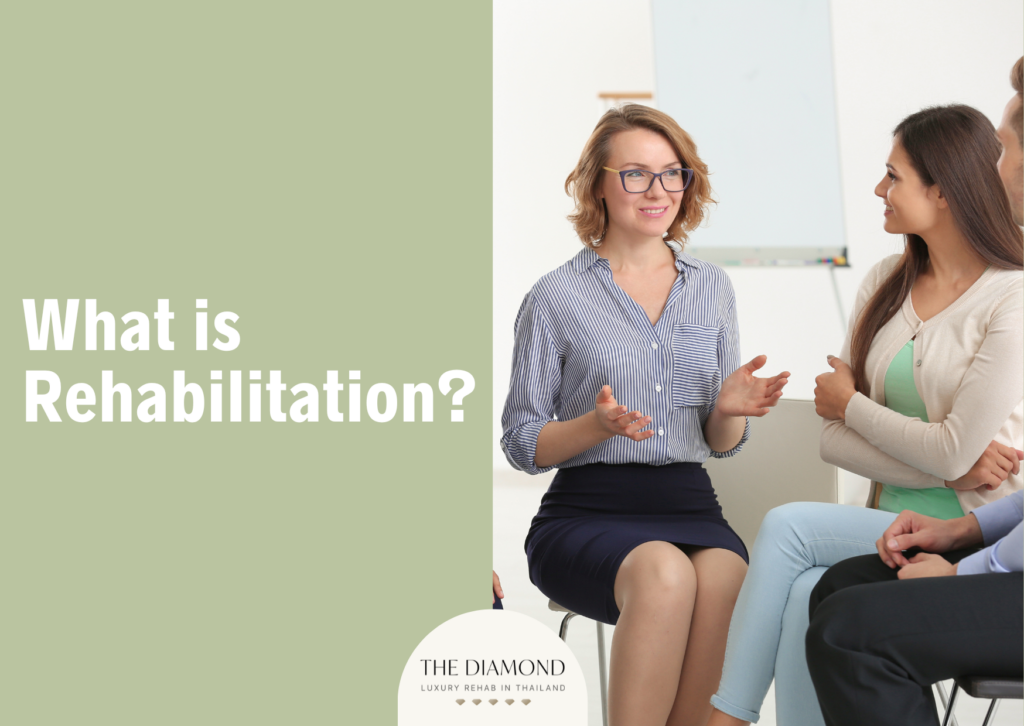
Rehabilitation is a set of interventions created to assist a person’s recovery from an injury, physical or mental illness, or substance abuse. The main goal of rehabilitation is to optimize a patient’s functioning and improve their quality of life.
The benefits of rehabilitation are physical, psychological, lifestyle, and even economic, depending on the type of rehabilitation.
The main rehabilitation examples are listed below.
- Physical rehabilitation
- Substance use disorder rehabilitation
- Mental health rehabilitation
- Cancer rehabilitation
- Brain injury rehabilitation
- Post-surgery rehabilitation
- Developmental disabilities rehabilitation
- Occupational therapy
What are the rehabilitation types?
There are several types of rehabilitation ranging from substance use disorder rehabilitation to mental health rehabilitation. The rehabilitation types and their differences are listed below.
- Rehabilitation for substance use disorders: Helps persons with addiction to stop compulsive use and seeking of substances.
- Mental health rehabilitation: Helps individuals with serious and persistent mental illness to develop the social, emotional, and intellectual skills necessary for life in the community.
- Cancer rehabilitation: Helps patients with cancer restore or maintain their emotional and physical wellbeing.
- Brain injury rehabilitation: Improves a patient’s ability to function after physical and mental problems caused by traumatic brain injury.
- Post-surgery rehabilitation: Re-establishes joint motion and muscle strength.
- Developmental disabilities rehabilitation: Supports persons with developmental disabilities, i.e., a group of conditions caused by impairment in language, physical, learning, and behavior areas.
- Physical therapy: Works to regain function and help a patient return to activity.
- Occupational therapy: Focuses on maximizing independence and function in daily living skills.
For example, a person with addiction needs substance use disorder rehabilitation which often includes psychiatric support and treatment.
A person with a post-accident injury that impairs movement can benefit from rehabilitation that includes physical therapy. The healthcare provider refers a patient to the specific type of rehabilitation they need.
In fact, the greatest advantage of rehabilitation is its person-centered approach. One size does not fit all, in this case. For that reason, rehabilitation is not something a patient should do on their own, without professional guidance.
What areas are covered in rehabilitation?
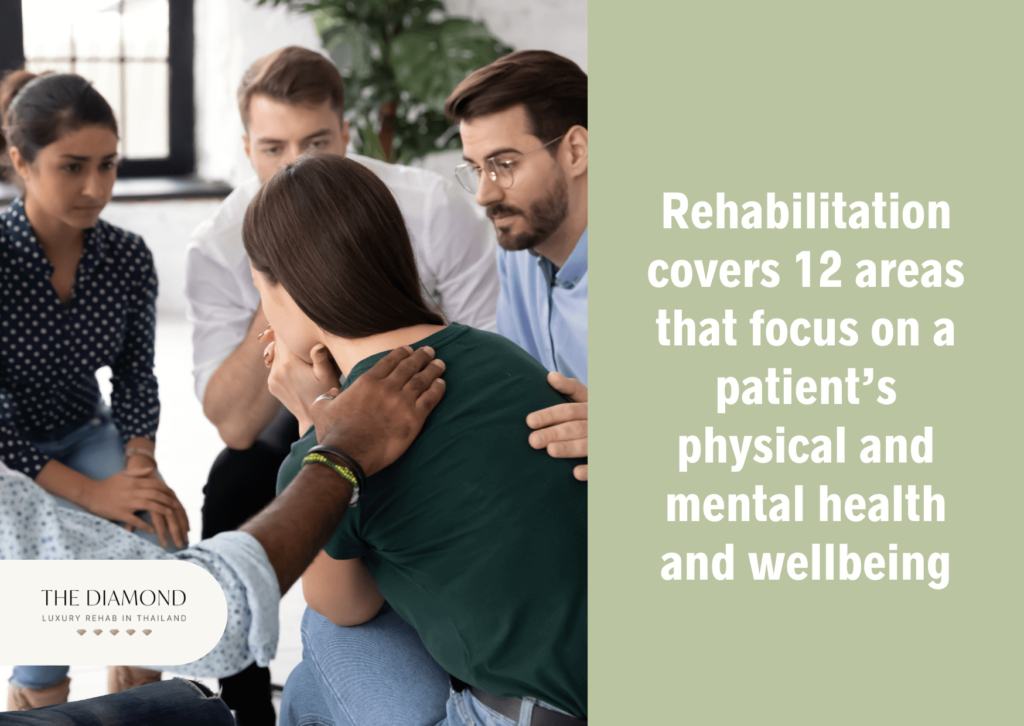
Rehabilitation covers 12 areas that focus on a patient’s physical and mental health and wellbeing. The areas of rehabilitation and their examples are listed below.
- Physical care: Using special exercises to regain strength and mobility after an injury.
- Family support: Providing support and counseling to a family member during a hard time.
- Self-care: Taking care of oneself by making changes that make daily tasks easier.
- Psychological counseling: Using therapy sessions that provide psychological relief and improve wellbeing.
- Pain management: Using various strategies to cope with pain (including CBT)
- Vocational training: Learning a new skill that helps improve the quality of living
- Socialization skill: Learning and practicing skills necessary for effective communication and coping with the environment.
- Cognitive skill: Exercising memory games and pattern detection.
- Communication skill: Practicing how a person communicates with others.
- Respiratory care: Exercising procedures that help patients with heart and pulmonary diseases improve their breathing.
- Mobility skills: Training how to use a white cane (for visually impaired people).
- Education: Providing lessons, training, and counseling to ensure a patient is well-informed.
1. Physical care
Physical care is a program that aims to alleviate pain, improve mobility and range of motion, and provide rehabilitation after surgery, injury, stroke, and other problems.
Many people believe physical care is just a set of exercises, but it may also include other approaches such as massage, heat or cold therapy, balance and gain training, cardiovascular strengthening, among others.
Before the program begins, physical therapy evaluates a patient to create a specific plan for their needs. The costs of physical therapy range between $20 and $350 per session.
2. Family support
Family support is the support that a family provides to its member in need. Their acceptance and support help a patient deal with their health condition, mental health illness, injury, and addiction.
The exact form of family support in rehabilitation varies. Sometimes family therapy sessions are necessary, but in the case of dementia and Alzheimer’s patients or other persons with physical impairments, family members also learn how to provide care.
3. Self-care skills
Self-care skills are the activities that allow a person to take care of their own body. These skills also relate to the performance of daily life tasks.
Patients learn how to adopt new habits that will help them gain more independence. They often learn to get dressed, groom, do personal hygiene, and perform other tasks that can make their lives easier.
4. Psychological counseling
Psychological counseling is the process of assisting patients with mental health and emotional issues to improve their sense of well-being, resolve crises, and decrease feelings of distress.
Many forms of rehabilitation require psychological counseling primarily because addiction, accidents, diseases, injuries, and developmental impairments all have a major impact on a person’s mental health and wellbeing. People also need psychological counseling for anxiety, depression, bipolar disorder, and other mental health conditions.
There are several approaches or therapies in psychological counseling, including cognitive-behavioral therapy (CBT), psychodynamic therapy, humanistic therapy, and integrative therapy.
Like with physical therapy, the psychological counseling approach varies from patient to patient. The goal here is to help patients develop more confidence and better coping mechanisms to effectively handle the challenges they face.
5. Pain management
Pain management is a physical and psychological approach for persons with chronic pain. The program combines multiple specialties to provide an individualized treatment plan.
The main objective of pain management is to help people have a more active lifestyle. It may incorporate physical, behavioral, and occupational therapies.
A common misconception is that pain management is treated with medications only. As a part of rehabilitation, pain management shows it is possible to deal with pain with other strategies too.
6. Vocational training
Vocational training is a course or program that focuses on skills necessary for a specific trade or job function. More precisely, vocational training helps people with psychiatric, physical, and learning disabilities find and retain a job.
Once applied to the program, a patient receives an individualized treatment plan, training, guidance, counseling, and other services that can help them.
7. Socialization skill
Socialization skill training helps patients have a more functional life and cope with their environment successfully. The main goal of socialization skills is to integrate patients into their community. This may include group sessions and recreational therapy.
8. Cognitive skill
The cognitive skill involves relearning or improving abilities that were lost or impaired due to neurodegenerative conditions, stroke, or brain injuries. Cognitive rehabilitation includes education, process training, strategy training, and functional activities training.
An important aspect of cognitive skill training in rehabilitation is the use of cognitive stimulation. This means a patient is taught to stimulate a certain ability and use different skills to carry out the task.
Cognitive skills include memory, attention, decision-making, safety awareness, and problem-solving.
9. Communication skill
Communication skill helps a patient communicate with their surroundings more effectively. It helps a person ensure the right messages are being conveyed.
A patient learns to understand others and be understood by them. Communication skill is also important in family support as it allows patients to talk about what they are going through.
10. Respiratory care
Respiratory care is a system that includes education, physical activity, and support to improve breathing and lung function. Respiratory therapists show techniques that enable patients to have a more normal life.
It’s useful to mention respiratory care can benefit a wide range of patients ranging from premature infants whose lungs haven’t developed properly to older men and women with lung disease.
11. Mobility skills
Mobility skills are the process of helping a patient move efficiently and safely from one place to another. At the same time, this aspect of rehabilitation works to reduce the risks of trips, falls, and accidents.
Mobility exercises improve the range of motion and flexibility. They are helpful for persons who are recovering from injuries, surgery, or stroke. The exact program depends on each patient and the cause of impaired mobility.
12. Education
Patient education is a process that helps to improve adherence to the rehabilitation program, medications, and diet. It also improves communication.
Patient education is extremely important because the patients get more realistic expectations and improved confidence in the whole process.
What are the key facts about rehabilitation?
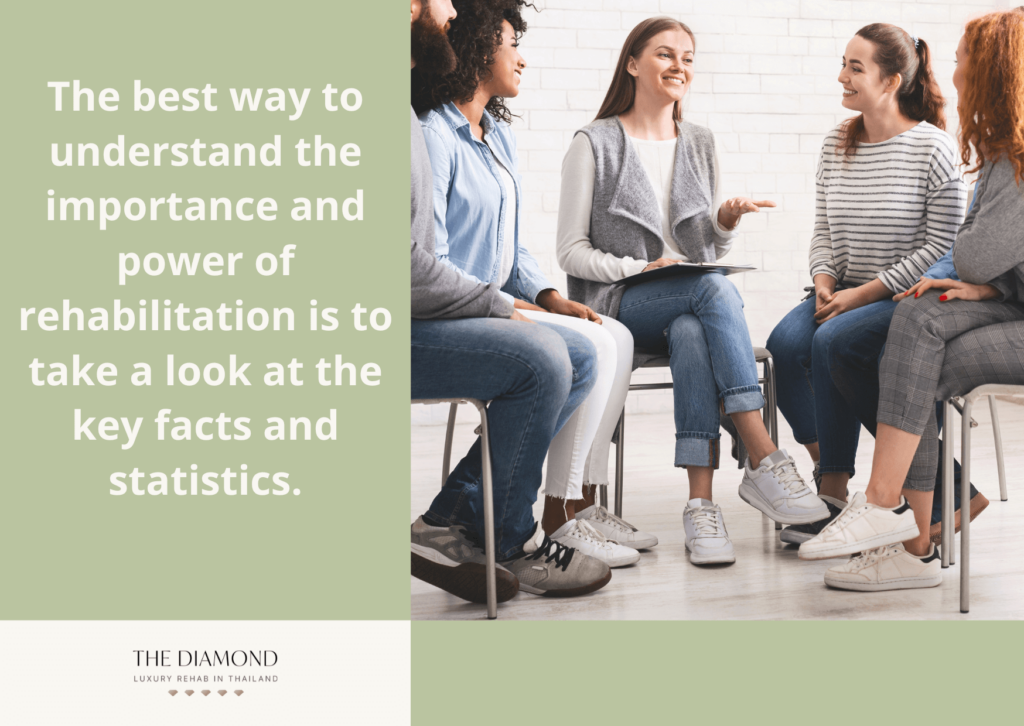
The best way to understand the importance and power of rehabilitation is to take a look at the key facts and statistics. The key facts about rehabilitation are listed below:
- One study found 66.2% growth in estimated years lived with disability (YLD) counts thanks to physical rehabilitation. This growth was observed worldwide in countries of varying income levels.
- About 2.4 billion people need rehabilitation services. Yet, in some countries, around 50% of people who need these services do not receive them.
- In 2017, about 20.7 million people in the US needed treatment for a substance use disorder, but only 4 million (19%) received it. In 2018, the number of people who needed rehabilitation for substance use disorder increased to 21.2 million.
- Physical therapy, as a part of multidisciplinary approaches, can provide long-term improvement in pain and functional status in persons with chronic non-specific low back pain.
- The cognitive rehabilitation program has a positive influence on independence in patients with dementia. Multidisciplinary cognitive rehabilitation can improve cognitive stability and quality of life in Alzheimer’s patients, decrease symptoms of depression and caregiver burden.
- For some deficits caused by stroke, starting rehabilitative care within the first two weeks is beneficial, a study showed.
- Rehabilitation is a vital part of universal health coverage
- Rehabilitation helps patients of all ages, children and adults alike
What are the benefits of rehabilitation?
Rehabilitation has a wide range of benefits that only confirm its importance for people with different needs. The benefits of rehabilitation are listed below.
- Reduces the impact of various acute or chronic health conditions, injuries, and mental or physical illnesses.
- Minimizes or slows down disabling effects of chronic health problems like cancer, cardiovascular disease, and diabetes
- Equips people with self-management strategies to cope with their health condition
- Helps avoid costly hospitalization or decreases the length of hospital stay and prevents readmissions to hospitals.
- Allows persons to take part in education and gain employment, remain as independent as they can be, and minimizes the need for a caregiver or financial support
- Decreases intensity of pain to help people be more active and perform day to day activities without discomfort
- Restores pre-injury or pre-illness functionality and mobility
- Enhances a person’s confidence and improves their mental health
- Provides a person much-needed structure when recovering from addiction
- Provides a safe and supportive environment where a person is surrounded by people who know what they are going through
- Helps form new habits and define goals
- Focuses on physical and psychological health and wellbeing
- Provides ongoing support
The most significant benefit of rehabilitation is reducing the impact of a specific health condition, addiction, injury, or another form of physical/psychological impairment. That way, rehabilitation has the potential to improve a patient’s quality of life.
Addictions, injuries, and diseases do not affect a single organ or body part only. They have a major impact on a person’s life, work, relationships, and other aspects.
By lessening the impact of injuries, diseases, and addiction, rehabilitation can help a person get their life back on the right track.
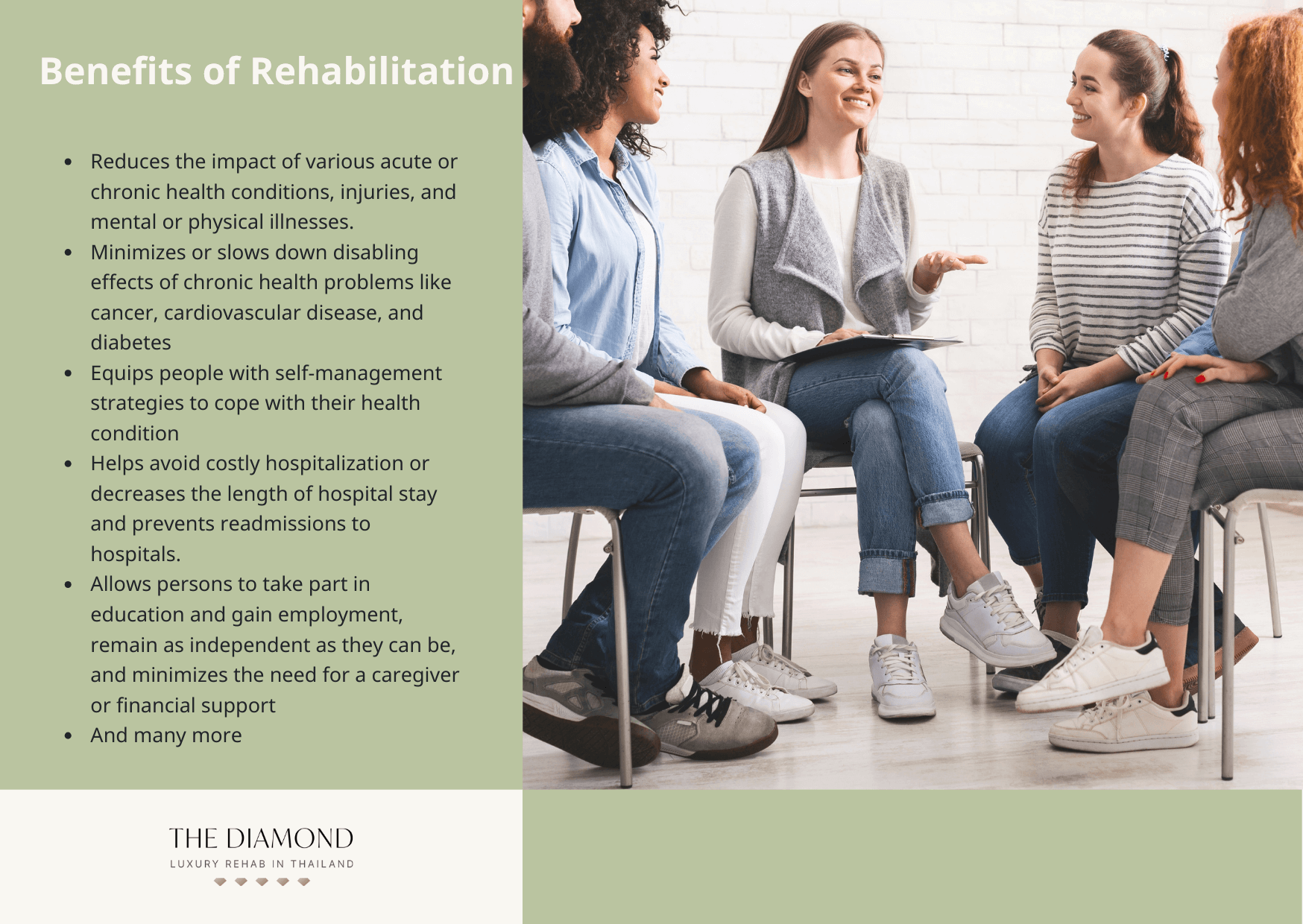
What are the misconceptions about rehabilitation?
The biggest misconception about rehabilitation is that it’s only meant for persons with long-term physical impairments or men and women with addiction problems.
However, the truth is people with different acute or chronic health conditions, injuries, impairments, and other problems that limit their functioning can benefit from rehabilitation.
Other misconceptions about rehabilitation include:
- Rehabilitation is a luxury health service
- Rehabilitation is the approach we take only when other treatment options don’t work
- Rehabilitation doesn’t work for healing
- You have to hit rock bottom first and then sign up for rehabilitation
- I will get fired if I go to rehab
- Rehabilitation is a waste of time
- Once you’re done with rehabilitation, you are healed
- Physical therapy is just exercise-based
- If you go to a rehabilitation center more than once, you are a failure
What initiative did the WHO launch for rehabilitation?
In February 2017, World Health Organization (WHO) launched The Rehabilitation 2030 initiative as a call for action to strengthen rehabilitation in health systems across the globe.
The WHO reported one in three people worldwide are living with a health condition that can benefit from rehabilitation. That number is expected to grow as populations continue to age and the prevalence of chronic diseases is going up.
Unfortunately, many countries aren’t equipped enough to respond to the existing rehabilitation needs, much less to the expected increases.
For that reason, WHO identified 10 priority areas. The priorities of the WHO Rehabilitation 2030 initiative are listed below.
- Creating strong political and leadership support for rehabilitation on every level from sub-national to global
- Strengthening both planning and implementation of rehabilitation at all levels, including in emergencies
- Making improvements in the integration of rehabilitation within the health sectors
- Making rehabilitation a part of universal health coverage
- Building delivery models of rehabilitation services to ensure they are comprehensive and allow for equal access to quality care, even for persons in remote and rural regions
- Building a strong multidisciplinary rehabilitation workforce and promoting it in the education of the health workforce
- Use adequate mechanisms to expand rehabilitation financing
- Collecting relevant information on rehabilitation to improve information systems in the health industry
- Do more research to expand the body of evidence for the use of rehabilitation
- Making partnerships to improve the quality of rehabilitation, preferably among high- and low-income nations
What emergencies can create a need for rehabilitation?
Some emergencies generate the need for rehabilitation services due to complications they may cause. These complications are usually in the form of health conditions or injuries brought on by those specific emergencies. Besides increasing the need for rehabilitation, emergencies also impair the existing services.
Emergencies that can create the need for rehabilitation include:
- Earthquakes and other natural hazards
- Disease outbreaks
- Conflict and other human-induced hazards
- Terrorism
- Industrial accidents
What are the rehabilitation center types?
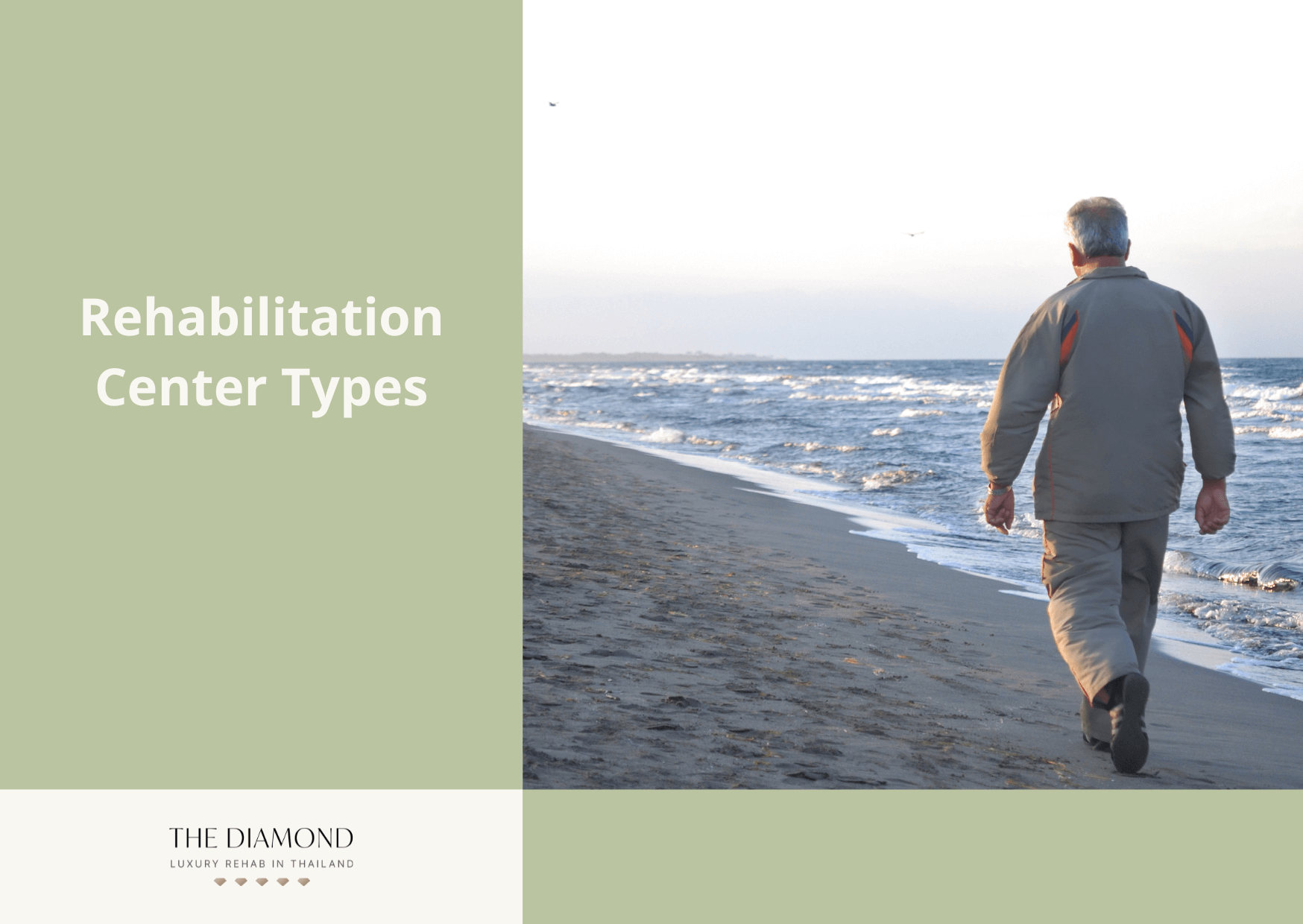
Rehabilitation is provided in different settings such as private clinics, inpatient and outpatient hospital settings, community settings, and even in a patient’s home (depending on the type of rehabilitation, of course). Of course, people can also get these services in rehabilitation centers. The types of rehabilitation centers include:
- Drug rehabilitation center: Helps people recover from drug addiction
- Alcohol rehabilitation center: Helps people recover from alcohol abuse (in many cases, the same center offers both alcohol and substance abuse treatment)
- Physical therapy rehabilitation center: Offers inpatient or outpatient physical therapy services. Outpatient rehabilitation is necessary for minor injuries and for restoring health after some illnesses. Inpatient physical therapy is necessary for patients who had a joint replacement, injury, disease, or complex surgical procedures.
- Psychiatric/mental health rehabilitation center: Provides intensive support and rehabilitative services to persons with mental health disorders and severe symptoms. It helps people develop skills necessary for greater functioning and independence.
- Stroke rehabilitation center: Provides individualized and specialized services to help patients regain movement, speech, and independence after stroke.
- Brain injury rehabilitation center: Helps patients minimize the long-term impact of a brain injury. Brain injury rehabilitation centers can be freestanding or a part of bigger hospitals.
- Cancer rehabilitation center: Creates multidisciplinary support for cancer patients and their journey. While there are standalone centers, many hospitals have cancer rehabilitation programs too.
